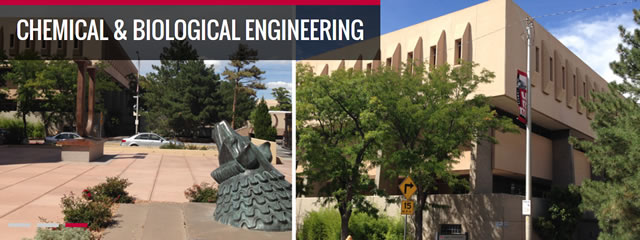
Chemical and Biological Engineering ETDs
Publication Date
Spring 5-13-2019
Abstract
This doctoral dissertation presents three topics in modeling fluid transport through porous media used in engineering applications. The results provide insights into the design of fuel cell components, catalyst and drug delivery particles, and aluminum- based materials. Analytical and computational methods are utilized for the modeling of the systems of interest. Theoretical analysis of capillary-driven transport in porous media show that both geometric and evaporation effects significantly change the time dependent behavior of liquid imbibition and give a steady state flux into the medium. The evaporation–capillary number is significant in determining the time-dependent behavior of capillary flows in porous media. The analytical solutions for the front position for 1D and 2D capillary flows and under normal evaporation agree with experimental results.
The lattice Boltzmann method (LBM) is used for versatile and flexible modeling of pore-scale phenomena in porous media. The LBM is used to show the the effects of various physical phenomena, such as multiphase, electrochemical, and dissolution, on pitting corrosion of aluminum surfaces in corrosive environments. In particular, each of these phenomena may spontaneously manifest phenomenological asymmetries that influence the growth of the corroding pit. Fluid motion in bimodal porous particles shows heterogeneous flow behavior in the medium. A brief discussion is given on implementations of parallel lattice Boltzmann schemes for future increase in simulation model capabilities. Each of these topic areas may be extended by further combining models of important physical phenomena.
In the appendices, additional prospective results are overviewed. The font shape of capillary wicking from a finite line source into a 2D domain agrees qualitatively with empirical observations. A discussion of the background and application of the LBM to stress corrosion cracking in aluminum is given, where we show that thin cracks will retain liquids better than wide cracks. Using a finite element model, we show that flow through discrete mono-porous particles increases with increasing velocity and permeability for low characteristic velocity; this scaling law shows that flow rate is proportional to the Reynolds number times the square root of the Darcy number.
Keywords
Porous Media, Lattice Boltzmann Method, Capillary Flow, Evaporation, Aluminum Corrosion, Biporous Media
Document Type
Dissertation
Language
English
Degree Name
Chemical Engineering
Level of Degree
Doctoral
Department Name
Chemical and Biological Engineering
First Committee Member (Chair)
Dimiter N. Petsev
Second Committee Member
Daniel Appelo
Third Committee Member
Plamen Atanassov
Fourth Committee Member
Frank van Swol
Recommended Citation
Benner, Eric M.. "Fluid Transport in Porous Media for Engineering Applications." (2019). https://digitalrepository.unm.edu/cbe_etds/64
Included in
Fluid Dynamics Commons, Hydrology Commons, Numerical Analysis and Scientific Computing Commons, Transport Phenomena Commons
